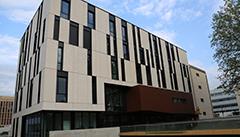
Sciences & Société
Soutenance de thèse : Zineb BOULAAJAJ
Numerical and experimental study of crack propagation on monocrystalline silicon wafers
Doctorante : Zineb BOULAAJAJ
Laboratoire INSA : LaMCos
Ecole doctorale : ED162 : Mécanique, Energétique, Génie Civil, Acoustique de Lyon
Mechanical failure is a critical phenomenon affecting the electrical performances of monocrystalline silicon, which is commonly used for solar cells and microelectromechanical systems. The main cause behind the catastrophic failure of such Si components is dynamic crack propagation. Numerous studies were conducted to apprehend this cleavage failure both at the initiation of the crack and along its propagation. Interestingly, it was found that crack propagation in monocrystalline silicon can reach up to 80% of Rayleigh wave speed. This threshold value has made us question whether some micro-processes or dissipation phenomena are taking place in the vicinity of the crack.
As part of the efforts made to shed light on the kinetic aspects of cracks, a numerical study is carried out to predict its propagation velocity and evolution. The inertial effects are accounted for using an explicit integration scheme. An exhaustive study was conducted to determine the numerical parameters that could control or influence the onset and the evolution of rapid crack propagation. Since we initially aimed at reproducing experimental bending tests, a three- dimensional model was necessary. The fracture approach XFEM was used and the explicit 3D model was implemented on the open-source code Cast3m.
A series of fracture experiments employing the potential drop technique were performed to characterize the crack velocities precisely. The samples were thin monocrystalline wafers onto which a thin chrome layer and gold electrodes are deposited. To control the crack path, a notch was made by hand on each wafer. The electrical circuit is a battery-feed Wheatstone bridge with our silicon wafer replacing one of the resistances. Crack propagation engenders a change in the voltage measurement. A relationship between the voltage across the wafer and the crack front position enables us to derive the crack velocity. This high-resolution experimental set-up is then validated by simultaneously performing the same measures using a high-speed camera.
Información adicional
-
Amphithéâtre Clémence Royer - 1er étage, Bâtiment Jacqueline Ferrand(GM) (Villeurbanne)

